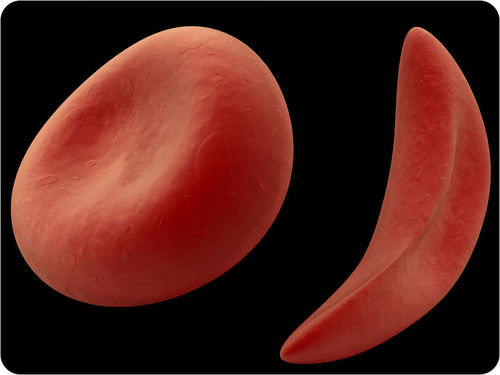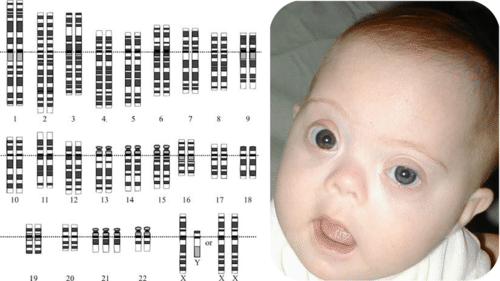3.3: Genetic Disorders
- Page ID
- 12069

Is being short-statured inherited?
It can be. Achondroplasia is the most common form of dwarfism in humans, and it is caused by a dominant mutation. The mutation can be passed from one generation to the next.
Genetic Disorders
Many genetic disorders are caused by mutations in one or a few genes. Other genetic disorders are caused by abnormal numbers of chromosomes.
Genetic Disorders Caused by Mutations
The Table below lists several genetic disorders caused by mutations in just one gene. Some of the disorders are caused by mutations in autosomal genes, others by mutations in X-linked genes. Which disorder would you expect to be more common in males than females?
| Genetic Disorder | Direct Effect of Mutation | Signs and Symptoms of the Disorder | Mode of Inheritance |
|---|---|---|---|
| Marfan syndrome | defective protein in connective tissue | heart and bone defects and unusually long, slender limbs and fingers | autosomal dominant |
| Sickle cell anemia | abnormal hemoglobin protein in red blood cells | sickle-shaped red blood cells that clog tiny blood vessels, causing pain and damaging organs and joints | autosomal recessive |
| Vitamin D-resistant rickets | lack of a substance needed for bones to absorb minerals | soft bones that easily become deformed, leading to bowed legs and other skeletal deformities | X-linked dominant |
| Hemophilia A | reduced activity of a protein needed for blood clotting | internal and external bleeding that occurs easily and is difficult to control | X-linked recessive |
Few genetic disorders are controlled by dominant alleles. A mutant dominant allele is expressed in every individual who inherits even one copy of it. If it causes a serious disorder, affected people may die young and fail to reproduce. Therefore, the mutant dominant allele is likely to die out of the population.
A mutant recessive allele, such as the allele that causes sickle cell anemia (see the Figure below and the link that follows), is not expressed in people who inherit just one copy of it. These people are called carriers. They do not have the disorder themselves, but they carry the mutant allele and can pass it to their offspring. Thus, the allele is likely to pass on to the next generation rather than die out.
 Sickle-Shaped and Normal Red Blood Cells. Sickle cell anemia is an autosomal recessive disorder. The mutation that causes the disorder affects just one amino acid in a single protein, but it has serious consequences for the affected person. This photo shows the sickle shape of red blood cells in people with sickle cell anemia.
Sickle-Shaped and Normal Red Blood Cells. Sickle cell anemia is an autosomal recessive disorder. The mutation that causes the disorder affects just one amino acid in a single protein, but it has serious consequences for the affected person. This photo shows the sickle shape of red blood cells in people with sickle cell anemia.Cystic Fibrosis and Tay-Sachs disease are two additional severe genetic disorders.
Chromosomal Disorders
Mistakes may occur during meiosis that result in nondisjunction. This is the failure of replicated chromosomes to separate during meiosis (the animation at the link below shows how this happens). Some of the resulting gametes will be missing a chromosome, while others will have an extra copy of the chromosome. If such gametes are fertilized and form zygotes, they usually do not survive. If they do survive, the individuals are likely to have serious genetic disorders. The Table below lists several genetic disorders that are caused by abnormal numbers of chromosomes. Most chromosomal disorders involve the X chromosome. Look back at the X and Y chromosomes and you will see why. The X and Y chromosomes are very different in size, so nondisjunction of the sex chromosomes occurs relatively often.
| Genetic Disorder | Genotype | Phenotypic Effects |
|---|---|---|
| Down syndrome | extra copy (complete or partial) of chromosome 21 (see Figure below) | developmental delays, distinctive facial appearance, and other abnormalities (see Figure below) |
| Turner’s syndrome | one X chromosome but no other sex chromosome (XO) | female with short height and infertility (inability to reproduce) |
| Triple X syndrome | three X chromosomes (XXX) | female with mild developmental delays and menstrual irregularities |
| Klinefelter’s syndrome | one Y chromosome and two or more X chromosomes (XXY, XXXY) | male with problems in sexual development and reduced levels of the male hormone testosterone |
 (left) Trisomy 21 (Down Syndrome) Karyotype. A karyotype is a picture of a cell's chromosomes. Note the extra chromosome 21. (right) Child with Down syndrome, exhibiting characteristic facial appearance.
(left) Trisomy 21 (Down Syndrome) Karyotype. A karyotype is a picture of a cell's chromosomes. Note the extra chromosome 21. (right) Child with Down syndrome, exhibiting characteristic facial appearance.Diagnosing Genetic Disorders
A genetic disorder that is caused by a mutation can be inherited. Therefore, people with a genetic disorder in their family may be concerned about having children with the disorder. Professionals known as genetic counselors can help them understand the risks of their children being affected. If they decide to have children, they may be advised to have prenatal (“before birth”) testing to see if the fetus has any genetic abnormalities. One method of prenatal testing is amniocentesis. In this procedure, a few fetal cells are extracted from the fluid surrounding the fetus, and the fetal chromosomes are examined.
Treating Genetic Disorders
The symptoms of genetic disorders can sometimes be treated, but cures for genetic disorders are still in the early stages of development. One potential cure that has already been used with some success is gene therapy. This involves inserting normal genes into cells with mutant genes.
If you could learn your risk of getting cancer or another genetic disease, would you? Though this is a personal decision, it is a possibility. A number of companies now make it easy to order medical genetic tests through the Web.
Summary
- Many genetic disorders are caused by mutations in one or a few genes.
- Other genetic disorders are caused by abnormal numbers of chromosomes.
Review
- Describe a genetic disorder caused by a mutation in a single gene.
- What causes Down syndrome?
- What is nondisjunction?
- What is gene therapy?
- Explain why genetic disorders caused by abnormal numbers of chromosomes most often involve the X chromosome.
Resources
| Image | Reference | Attributions |
 |
[Figure 1] | Credit: Karyotype: Courtesy of National Human Genome Research Institute; Photo: Erin Ryan;Courtesy of Drs. Noguchi, Rodgers, and Schechter of the National Institute of Diabetes and Digestive and Kidney Diseases Source: commons.wikimedia.org/wiki/File:Down_Syndrome_Karyotype.png ; Photo: commons.wikimedia.org/wiki/File:Brushfield_eyes.jpg ; Sickle cells: commons.wikimedia.org/wiki/File:Sicklecells.jpg ; Red blood cells: commons.wikimedia.org/wiki/File:Redbloodcells.jpg License: Public Domain |
 |
[Figure 2] | Credit: Image copyright Sebastian Kaulitzk, 2013 Source: http://www.shutterstock.com License: Used under license from Shutterstock.com |
 |
[Figure 3] | Credit: Karyotype: Courtesy of National Human Genome Research Institute; Photo: Erin Ryan Source: Karyotype: commons.wikimedia.org/wiki/File:Down_Syndrome_Karyotype.png ; Photo: commons.wikimedia.org/wiki/File:Brushfield_eyes.jpg ; commons.wikimedia.org/wiki/File:Down_Syndrome_Karyotype.png ; Photo: commons.wikimedia.org/wiki/File:Brushfield_eyes.jpg License: Public Domain |

